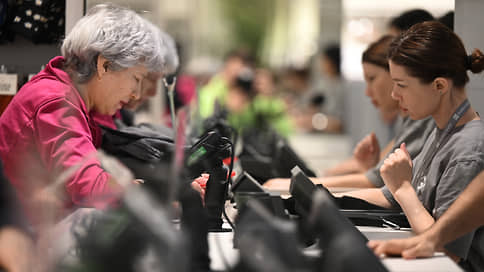Rosstat for June-July 2023 records a rapid growth in demand from households and companies
[ad_1]

The shift of much private consumption into Russia, supported by the realization of pent-up demand, reduced supply of familiar goods, and labor shortages, have led to a boom in consumption, investment, and employment. The real annual growth rate of retail trade in July reached 10.5%, wages in June – 10.5%, capital investments in the second quarter of 2023 – 12.6%. Analysts believe that the heated economy in July continued to deviate from the historical trend. The Ministry of Economy estimates GDP growth in January-July at 2.1%, but so far the only consensus forecast for 2023, made after the increase in the key rate of the Central Bank at the end of July, does not imply a noticeable cooling until the end of the year.
fresh portion data Rosstat for June-July 2023 records a rapid and accelerating last month growth in demand from households and companies. Thus, according to the Ministry of Economy, the total volume of consumption (the sum of the turnover of retail, catering and services) in July increased by 9.1% year-on-year (by 2.9% compared to July 2021) after an increase of 8.9% in June, and seasonally adjusted for the month, the increase was 1.1% (1% in June). The growth leader was the consumption of manufactured goods, services and public catering, which is in line with the leading indicators of Sberindex and the growth of consumer sentiment against the backdrop of accelerated inflation, wages and lending, and later the weakening of the ruble, which caused an increase in demand for non-food products.
According to Rosstat, the annual growth rate of real wages jumped to 10.5% in June from 10% in May; loans to individuals, we recall, grew in June by 17.4% (and 1.7% seasonally adjusted for the month) and accelerated growth to 18.3% in July.
According to analysts of the Telegram channel “Hard Numbers”, the nominal dynamics of salaries in the private and public sectors has converged (in 2021 and the first half of 2022, the latter lagged behind). In July, wage growth rates were led by the production of clothing (nominally by 58.4% yoy), rubber, plastic (25.3%) and tobacco products (24.6%). In the automotive industry, on average, they began to receive 24.2% more, which compensates for last year’s lag, and in “special industries” (production of metal products, electronics and optics, electrical equipment, etc.) on average – by 21.9%.
The CMASF also notes that it was the growth of wages in the second quarter that provided 4.7 percentage points out of 5% of the growth in real incomes of the population. Meanwhile, according to the center’s expert Igor Polyakov, the “partial overheating” of consumption during the implementation of pent-up demand, “which had been accumulating for a year and a half”, stopped in July 2023, and the total consumption of citizens (the same amount of retail, catering and services turnover) decreased seasonally adjusted for the month by 0.2%.
Such strong discrepancies in the estimates of the CMASF and the Ministry of Economy have not been observed before. “This (current discrepancy.— “b”) is rather strange. It is not clear where such growth can come from when public catering, food and services did not grow along the trend,” Mr. Polyakov wonders. The only explanation so far can be the calculation of the Ministry of Economy of consumption of the population outside the Russian Federation, official data on which are far behind, he admits. Note that Sberindex also indicates a significant increase in the volume of purchases of Sber card users in July and August, taking into account consumption abroad, and the Central Bank recorded a continuing increase in consumer sentiment in August.
The rapid expansion of domestic demand, however, is also indicated by data from Rosstat on capital investments – in the second quarter they increased by 12.6% year-on-year (by 6.3% qoq seasonally adjusted, according to the Ministry of Economy) against an increase of 0.7 % a quarter earlier. The main source of capital investments of large and medium-sized enterprises in the second quarter is their own funds (in the first half of the year their share in the total volume was 58.9% against 58.2% a year ago), investments increased in annual terms by 18.2% against a decrease of 3 .9% for the first quarter – profit in the economy before taxes in January-June was 36% higher than a year ago. State investments also grew noticeably – by 15.2% in the second quarter (by 15.9% from the federal budget against 38.7% in the first quarter and by 20% from the regional ones after a decrease of 0.5%). The share of budget investments in the first half of the year reached 16.7% (15.6% a year ago).
As a result, according to the Ministry of Economy, seasonally adjusted GDP growth accelerated to 0.5% in July (0.1% a month earlier), since the beginning of the year the economy grew by 2.1% (1.6% in the first half of the year).
“According to our estimates, the output of basic sectors in July added 7.8% yoy. The economy deviates upwards from the historical trend, therefore, the output gap is growing,” analysts of the Solid Numbers Telegram channel note. Obviously, a sharp increase in the key rate of the Central Bank at the end of July should slow down the overheated economy. The government expects that by the end of 2023, GDP will grow by more than 2%, and the Central Bank – by 1.5-2.5%. So far, the only consensus forecast made by analysts at the HSE Development Center after the increase in the key rate assumes the economy will expand by 1.8% in 2023. In other words, no quick and noticeable cooling is expected, given the technical slowdown in GDP growth rates on a high base in 2022 by the end of this year.
[ad_2]
Source link






